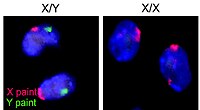| Part of a series on |
| Sex |
|---|
 |
| Biological terms |
| Sexual reproduction |
| Sexuality |
| Sexual system |
Human reproduction is sexual reproduction that results in human fertilization to produce a human offspring. It typically involves sexual intercourse between a sexually mature human male and female.[1] During sexual intercourse, the interaction between the male and female reproductive systems results in fertilization of the ovum by the sperm to form a zygote.[1] While normal cells contain 46 chromosomes (23 pairs), gamete cells only contain 23 single chromosomes, and it is when these two cells merge into one zygote cell that genetic recombination occurs and the new zygote contains 23 chromosomes from each parent, giving it 46 chromosomes (23 pairs).[2] The zygote then undergoes a defined development process that is known as human embryogenesis, and this starts the typical 9-month gestation period that is followed by childbirth. The fertilization of the ovum may be achieved by artificial insemination methods, which do not involve sexual intercourse.[3] Assisted reproductive technology also exists.
- ^ a b Jones, Richard E. (1991), "The Male Reproductive System", Human Reproductive Biology, Elsevier, pp. 72–93, doi:10.1016/b978-0-12-389770-1.50008-1, ISBN 9780123897701
- ^ "Gametogenesis – an overview | ScienceDirect Topics". sciencedirect.com. Retrieved 2022-09-12.
- ^ Ombelet, W.; Van Robays, J. (2015). "Artificial insemination history: hurdles and milestones". Facts, Views & Vision in ObGyn. 7 (2): 137–143. ISSN 2032-0418. PMC 4498171. PMID 26175891.